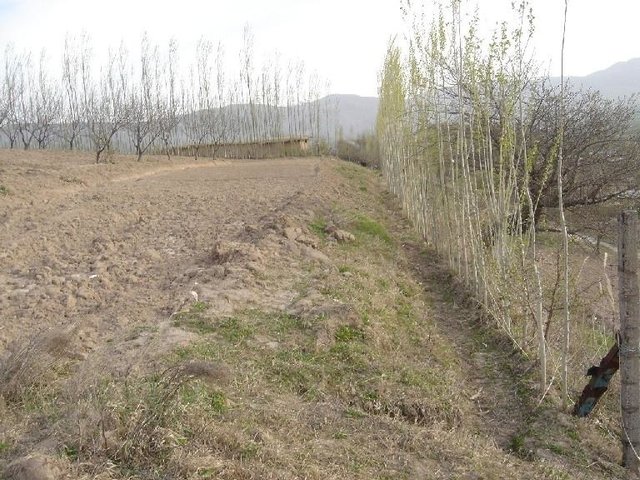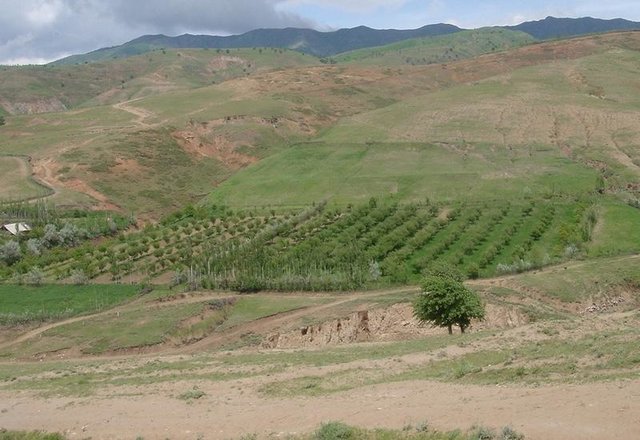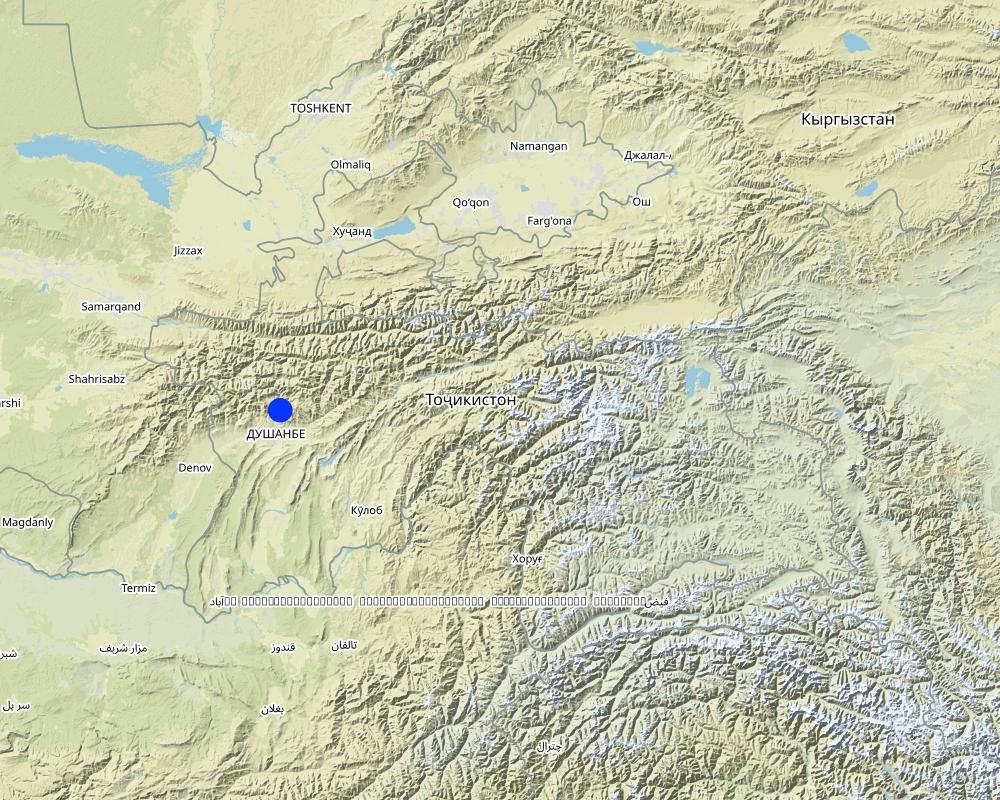Voluntary Labour Assistance [Tajikistan]
- Creation:
- Update:
- Compiler: Erik Bühlmann
- Editor: –
- Reviewers: David Streiff, Alexandra Gavilano, Joana Eichenberger
approaches_2643 - Tajikistan
View sections
Expand all Collapse all1. General information
1.2 Contact details of resource persons and institutions involved in the assessment and documentation of the Approach
Name of project which facilitated the documentation/ evaluation of the Approach (if relevant)
Pilot Program for Climate Resilience, Tajikistan (WB / PPCR)Name of the institution(s) which facilitated the documentation/ evaluation of the Approach (if relevant)
NCCR North-South (NCCR North-South) - Kyrgyzstan1.3 Conditions regarding the use of data documented through WOCAT
The compiler and key resource person(s) accept the conditions regarding the use of data documented through WOCAT:
Yes
1.4 Reference(s) to Questionnaire(s) on SLM Technologies

Terrace with Tree Barrier [Tajikistan]
Forward sloping terraces stabilised with aligned poplar trees and adjacent grass strips
- Compiler: Erik Bühlmann

Orchard-based Agroforestry (establishment of orchard) [Tajikistan]
Establishment of an orchard intercropping system on severely degraded cropland.
- Compiler: Erik Bühlmann
2. Description of the SLM Approach
2.1 Short description of the Approach
Voluntary labour assistance for labour intensive activities whereby community members help each other in contributing labour on the basis of mutual understanding.
2.2 Detailed description of the Approach
Detailed description of the Approach:
Aims / objectives: Members of the labour exchange group (often relatives and neighbours) can ask for assistance when labour intensive farm activities need to be performed. A farmer asks fellow land users individually for support. The request is made one or two weeks beforehand, informing individual farmers about the programme. During these informal land user exchanges, farmers share experiences and technical know-how on soil-and water conservation technologies and discuss details of the planned work. On the specified date, participants equip themselves with all necessary farm implements required for the activity. The farmer who seeks assistance should host the participants and prepare food and drinks. The objective of the approach is to alleviate labour shortages and to strengthen the relationship between community members.
2.5 Country/ region/ locations where the Approach has been applied
Country:
Tajikistan
Region/ State/ Province:
RRS
Further specification of location:
Faizabad
Map
×2.7 Type of Approach
- traditional/ indigenous
2.8 Main aims/ objectives of the Approach
The Approach focused mainly on SLM with other activities (approach is used for all labour intensive activities, such as construction work, establishment of SWC technologies, harvesting etc.)
To overcome labour constraints.
The SLM Approach addressed the following problems: shortage of work force, since most farmers send their sons (or go themselves) to Russia to earn money.
2.9 Conditions enabling or hindering implementation of the Technology/ Technologies applied under the Approach
availability/ access to financial resources and services
- hindering
Lack of finance to hire labour
Treatment through the SLM Approach: mutual voluntary labour assistance is independent from the financial situation of land users
legal framework (land tenure, land and water use rights)
- hindering
The existing land ownership, land use rights / water rights moderately hindered the approach implementation Presently, all land in Faizabad Rayon is rented from the state. Farmers are often not willing to implement labour intensive SWC technologies if they do not own the land they farm.
other
- hindering
Lack of able work force since many male villagers left to work in Russia.
Treatment through the SLM Approach: gathering of available work force to carry out labour intensive farming activities.
3. Participation and roles of stakeholders involved
3.1 Stakeholders involved in the Approach and their roles
- local land users/ local communities
Whilst decision making, planning and implementation of SWC technologies is mainly carried out by men, women assist mainly only for harvesting activities.
3.2 Involvement of local land users/ local communities in the different phases of the Approach
| Involvement of local land users/ local communities | Specify who was involved and describe activities | |
|---|---|---|
| initiation/ motivation | self-mobilization | |
| planning | self-mobilization | work is planned with advice of friends and elderly members |
| implementation | self-mobilization | |
| monitoring/ evaluation | none | |
| Research | none |
3.4 Decision-making on the selection of SLM Technology/ Technologies
Specify who decided on the selection of the Technology/ Technologies to be implemented:
- land users alone (self-initiative)
Explain:
Decisions on the method of implementing the SLM Technology were made by by land users* alone (self-initiative / bottom-up)
4. Technical support, capacity building, and knowledge management
4.1 Capacity building/ training
Was training provided to land users/ other stakeholders?
No
4.2 Advisory service
Do land users have access to an advisory service?
Yes
Specify whether advisory service is provided:
- on land users' fields
Describe/ comments:
Name of method used for advisory service: Informal land user extensions
Advisory service is quite adequate to ensure the continuation of land conservation activities
4.3 Institution strengthening (organizational development)
Have institutions been established or strengthened through the Approach?
- no
4.4 Monitoring and evaluation
Is monitoring and evaluation part of the Approach?
Yes
Comments:
Economic / production aspects were ad hoc monitored by 0 through measurements; indicators: None
Area treated aspects were ad hoc monitored by 0 through observations; indicators: None
There were no changes in the Approach as a result of monitoring and evaluation: None
4.5 Research
Was research part of the Approach?
No
5. Financing and external material support
5.1 Annual budget for the SLM component of the Approach
If precise annual budget is not known, indicate range:
- < 2,000
Comments (e.g. main sources of funding/ major donors):
Approach costs were met by the following donors: other (land user requesting for assistance): 100.0%
5.3 Subsidies for specific inputs (including labour)
If labour by land users was a substantial input, was it:
- voluntary
Comments:
The provision of food for voluntary assistance workers should be seen more as a part of traditional hospitality, rather than a food for work payment.
5.4 Credit
Was credit provided under the Approach for SLM activities?
No
5.5 Other incentives or instruments
Were other incentives or instruments used to promote implementation of SLM Technologies?
No
6. Impact analysis and concluding statements
6.1 Impacts of the Approach
Did the Approach help land users to implement and maintain SLM Technologies?
- No
- Yes, little
- Yes, moderately
- Yes, greatly
Through the approach, land users shared skills and knowledge, but could benefit from experiences of other farmers before establishment of an SWC technology.
Did the Approach improve issues of land tenure/ user rights that hindered implementation of SLM Technologies?
- No
- Yes, little
- Yes, moderately
- Yes, greatly
The approach eases the problem of labour shortages; the decision to implement substantial SWC technologies is still taken by the individual land user and his family. The problem is likely to be overcome in the near future. Awareness of land users about soil and water conservation can be increased through offering workshops and seminars. Improved SWC knowledge may lead to more sustainable land management through implementation of SWC technologies. However, in order to make fa..............
Did other land users / projects adopt the Approach?
- No
- Yes, little
- Yes, moderately
- Yes, greatly
The approach has evolved and developed within a Tajik rural community. Labour assistance can be requested by any farmer who is willing to help others as well.
6.3 Sustainability of Approach activities
Can the land users sustain what has been implemented through the Approach (without external support)?
- yes
6.4 Strengths/ advantages of the Approach
| Strengths/ advantages/ opportunities in the land user’s view |
|---|
| Eases the labour problem with very little costs. |
| Strengths/ advantages/ opportunities in the compiler’s or other key resource person’s view |
|---|
| Experiences and knowledge are shared. |
| Stronger social relationships among community members. |
| SWC technologies can be implemented more easily |
| Eases labour shortages. (How to sustain/ enhance this strength: The approach is sustainable in itself, as long as the approach is based on a mutual understanding.) |
| Farming activities can be carried out according to their seasonal calendar. |
6.5 Weaknesses/ disadvantages of the Approach and ways of overcoming them
| Weaknesses/ disadvantages/ risks in the land user’s view | How can they be overcome? |
|---|---|
| When assisting others, sometimes their own work cannot be carried out on time. |
| Weaknesses/ disadvantages/ risks in the compiler’s or other key resource person’s view | How can they be overcome? |
|---|---|
| If no means are available to host participants, farmers cannot request assistance. | |
| Only those farmers who have sufficient means to support other can participate in the approach. |
Links and modules
Expand all Collapse allLinks

Terrace with Tree Barrier [Tajikistan]
Forward sloping terraces stabilised with aligned poplar trees and adjacent grass strips
- Compiler: Erik Bühlmann

Orchard-based Agroforestry (establishment of orchard) [Tajikistan]
Establishment of an orchard intercropping system on severely degraded cropland.
- Compiler: Erik Bühlmann
Modules
No modules


